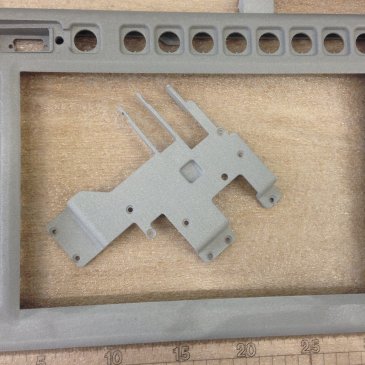3D printing by sintering a powder layer - in English powder bed fusion - is one of the 3D printing methods that allows you to 3D print from metal, plastic and ceramic materials. This 3D printing method is further divided into 4 different technologies:
-
Metal 3D printing
How the basic principle of 3D printing works by sintering a powder layer
3D printing by sintering a powder layer is simple in principle. The material in powder form is spread on the printing plate. The desired shape of the product layer is hardened by sintering the material.
After one layer is completed, the printing plate moves to the next level and another layer of curing powder is applied.
History
Metal production by conventional technological processes, such as casting, is very time-consuming and has several steps:
-
First, it is necessary to make a mock-up (sometimes also called a hoof, replica or master model), which must look exactly the same as the final product. The model can be made of different materials (wood, clay and others).
-
A form is then created from the model. The most used material for mold production is sand. A big disadvantage is that this mold is destroyed after each casting of the product and a new mold must be made. Another problem is that the mock-up is gradually destroyed during the creation of forms.
-
Casting is produced using a mold.
-
Finally, the casting must be surface treated. Above all, polish.
In the mid-1980s, the Selective Laser Sintering (SLS) 3D printing method was born at the University of Texas at Austin..
The startup DTM, which was thus created at that time, was bought by 3D Systems in 2001. The last patent protecting the mentioned 3D printing technology expired in 2014. This allowed other companies to develop their own 3D printers based on that technology.
Who is it for?
The method of 3D printing by sintering a powder layer has a high consumption of electricity (thus it is expensive) and at the same time it is quite dangerous. Therefore, it is not suitable for home use or for use in small businesses.
The prices of the cheapest 3D printers have not yet fallen below EUR 5,000. However, it is necessary to purchase additional equipment for the 3D printer, in which the 3D prints are hardened. Thus, the costs of 3D production with this technology can be doubled.
3D printers based on powder layer sintering technology are suitable for companies that will use them to the maximum. Only in this way can this investment be returned and paid off. These tend to be either manufacturing companies that include 3D printers in their production process or providers of 3D printing as a service.
Trends
All powder layer sintering 3D printing technologies are experiencing a huge boom today. This mostly applies to SLS 3D printing methods and metal 3D printing (SLM, DMLS methods). At the same time, new manufacturers are constantly being added. It often happens that a large company that manufactures precision parts develops or has its own solution developed, which it then brings to the market. Some companies do not sell their special 3D printers at all, but only provide this special 3D printing option as a bespoke service.
Although the price and size of these 3D printers are constantly decreasing, these technologies are not suitable for home hobby 3D printing or for offices. Abroad, this type of printer is successfully spreading to manufacturing companies and its further increase is expected.
Advantages
-
Wide possibility of using different materials - metal, ceramics, plastics
-
Print supports are not required for this type of 3D printing
-
The possibility to print shapes that cannot be produced by classical methods
-
Excellent mechanical properties of 3D prints
Disadvantages
-
Necessity of safety measures, because very fine powder is being worked with
-
More expensive cleaning of the environment and the printer from the material
-
High prices of 3D printers and materials for them
-
The need for additional steps to harden 3D prints



